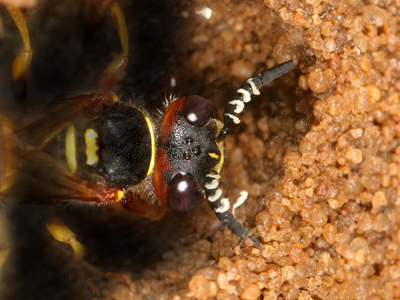Beewolves, a genus of solitary digger wasps, harbor symbiotic bacteria in their antennae. These symbionts produce an antibiotic cocktail of up to 49 different substances that protect their larvae from mold. The female insects catch honeybees, paralyze them with a sting, and drag them to previously constructed underground brood cells. Then they lay their eggs on the bees, which serve as food for the hatching larvae. As they lay their eggs, female beewolves deposit symbiotic bacteria in a white mass on the ceiling of the brood cells.
Beewolf eggs emit toxic nitric oxides
The beewolf offspring and the bees are constantly threatened by mold fungi, which quickly form in the moist soil of the brood cell and severely limit the storage life of the larva’s food source. From previous studies, the researchers knew that the eggs of beewolves release the toxic gas nitric oxide to kill mold fungi in the brood cell. “To us humans, nitric oxide is mainly known as an abundant component of car exhaust. The free radical can damage the respiratory system and interfere with oxygen transport in the body, which is why tailpipe gases are so dangerous to our health. The beewolf egg harnesses the toxic properties of nitric oxide to sanitize the brood cell in which it develops, preventing pathogen attack. However, the beewolf’s beneficial antibiotic-producing symbiont is also present in the brood cell when nitric oxide is released, so we wanted to find out how it survives the burst of toxic gas from the egg," lead author Tobias Engl from the Max Planck Institute for Chemical Ecology explains the objective of the study.
Initially, the researchers suspected that the bacteria could protect themselves from being poisoned. This hypothesis was supported by the fact that when the symbionts are confronted with the gas under in vitro conditions, i.e. outside the natural environment in a petri dish, genes involved in protection against the gas are up-regulated. "Further experiments showed that the response was not sufficient to survive the high concentrations of nitric oxide in the brood cell, and that the symbionts in the brood cell actually do not show this response at all," says Chantal Ingham from the Johannes Gutenberg University in Mainz, the second lead author.
Hydrocarbons provide protection against nitric oxide
The scientists found the key to solving their question when they took a closer look at the white substance secreted from the antennal glands of female beewolves. In particular, the research team studied the effect of the secretion and the hydrocarbons it contains against the toxic nitric oxide. Experiments showed that the hydrocarbons surrounding the symbiotic bacteria in the beewolf's antennal gland secretion block the diffusion of nitric oxide and prevent the bacteria from being harmed by the toxic gas.
"This is one of the few examples that clearly illustrate how an insect can protect its own symbionts during the vulnerable phase of transmission from one generation to the next. It also describes another exciting function of hydrocarbons, which in insects primarily protect against desiccation and natural enemies and mediate chemical communication," says Tobias Engl.
In many insect species, symbiotic bacteria are transmitted from one host generation to the next. On the one hand, this transmission can occur via the germline. However, symbionts are often localized outside the host for a period of time during transmission. "For most of these symbioses, it is unclear how the symbionts manage to survive outside the host, on which they usually highly depend. The beewolf symbiosis is a fascinating example of mutual protection: The symbionts protect the host from pathogens by producing antibiotics. The host, in turn, protects its symbionts from its own defenses against pathogens by producing a layer of hydrocarbons. Hence, the mechanism presented here demonstrates how these digger wasps can defend themselves against pathogens while maintaining the symbiosis with their bacterial helpers," says study leader Martin Kaltenpoth, who heads the Department of Insect Symbiosis at the Max Planck Institute in Jena, summarizing the significance of the study results.
Further experiments will now show whether the special hydrocarbon mixture of the beewolf is particularly well-suited to protect the symbionts, or whether basically any hydrocarbon could perform this task.


